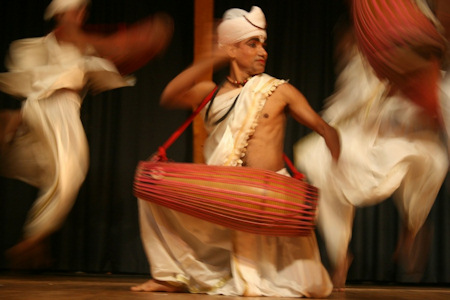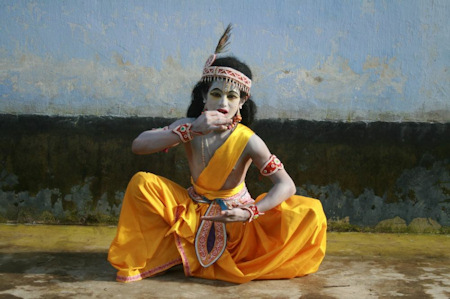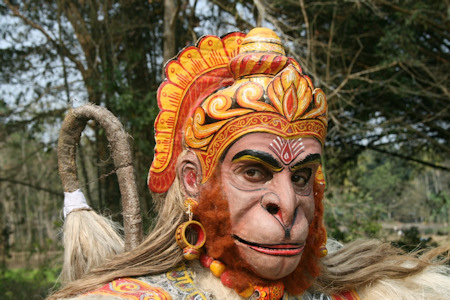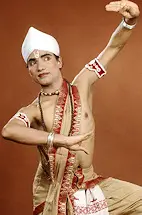Interview
BB: I am a worker of Sattriya
Dance, Drama and Music. I was fortunate to be born within the culturally and
spiritually rich family and environs of the Sattra, in Majuli, Assam. I grew up
soaking in the rich 550-year-old Satriya traditions combined with the colourful
tribal culture as well as the surrounding natural beauty of this unique riverine
island. I was inducted into the folds of the Uttar Kamalabari Sattra at the
tender age of four and started receiving training in the art forms of Nrittya,
Gayan, Bayan etc. from the renowned Gurus at the Sattra, i.c Ahdyapak
Paramananda Barbayan, Cheniram Barbayan, Boloram Bargayan, Tuniram Barbayan,
Gupiram Bargayan and Kamal Bargayan.
In 1993 I have received honour
‘Barbayan’ and ‘ Adhyapak’ in 1997 from the Satra authority. I have always
been a stellar performer and has been a recipient of ‘SANCHARI AWARD-2009’
and various scholarships from the CCRT, and Ministry of Culture , Govt. of
India etc. I also have two post-graduate degrees in Geography and Assamese
Literature from Dibrugarh University. I am doing Ph.D at the Rabindra Bharati
University, Kolkata on ‘Tala Patterns of Sattriya Dance: An attempt to
systematize the diverse forms as practiced in different Sattras’. I have
been composing quite a few Dance compositions like ‘Dhemali Samahar’, ‘Anga
Vihar’, ‘Badya Vihar’, ‘Nrishimhalila’ ‘ Dasavtar’, ‘Phagukhele’ ‘ Ishopasana’,
Tala Vihar’ ‘Ranga Prastavana’ ‘ Vrindavana Yatra’ etc and Script writings
of Dramas like ‘Sita Haran’, ‘Bali Badh’, ‘Setu Bandhan’, etc. all
written in Brajawali language. I have also produced and choreographed
various Sattriya dance items, dramas and Bhaonas; some of them being
quite innovative concepts. As a performer I have been performing and dazzling
the audience since the age of eight till date at various prestigious zonal,
national and international level events and platforms all over India and abroad.
I am
the first generation of Satra
based artist who led his group and conducted the Sattriya workshops in abroad
.Some of my remarkable performances are at ‘Festival Les Orientales, Saint
Florent Le Vieil’, ‘Festival De Musique Sacree, Abbaye De Sylvanes’, ‘Festival
Autres Rivages’, Uzes’ ‘Festival International De Folklore’, Issoire’ ‘Festival
Interfolk, Le Puy-en-Velay’ in France and ‘Festival Les Orientais, Evora,
in Portugal (2008) at Musée du Quai Branly, Paris (2010),
Mandapa, Paris, ‘Rencontres de la Danse Indienne, Montpellier’ (2011). I
gave workshops, master classes and lectures: in Rodez, Toulouse, Montpellier,
Uzès and Paris (2009 and 2011). ARTA ‘Performing Arts Tradition Research
Institute of Théâtre du Soleil, Paris’ (2010), Paris VIII University at
Artistic science department(2011). In collaboration with Aurélie Samuel,
curator of the textile department, I studied the Vindaravani Vastra at National Museum of Asian Arts Guimet, Paris
(2011).

BB:
Majuli is a river island in the Brahmaputra river, in the Indian state of
Assam. Majuli is often erroneously cited as the largest river island in the
world by the Indian media, but in fact it is merely the largest freshwater
island in South Asia. Majuli occupies an area of about 577 km², having lost
significant area due to erosion.
Majuli has been the cultural capital and the cradle of Assamese civilization for
the past five hundred years. The Satras (monastery) set up preserve antiques
like weapons, utensils, jewellery and other items of cultural significance.
Pottery is made in Majuli from beaten clay and burnt in driftwood fired kilns in
the same mode carried out by the peoples of the ancient Harrappan Civilisation.
Sociologists have stressed on the preservation of these unique peoples, whose
culture and dance forms are untouched by modernism. The handloom work of these
tribes is also internationally famous.
BB:
My parents sent me to the Sattra when I was four years old. There I was brought
up by my uncle, Adhyapak Baloram Bargayan, doyen of Sattriya music. He was the
seventh generation from our family to be sent to the Sattra. And since then I
have been learning Sattriya Dance, Bayan, Gayan, Ojapali, Namlagowa, Pathak,
Dramas (Ankia Bhaona) under the able guidance of respected Adhyapaks of Uttar
Kamalabari Sattra. I had begun playing with khol at early age when my father Mr.
Rampad Hazarika let me play with khol and introduced me how to produce such
divine sounds as his duty as a Borbayan of the village. Now what I am because of
my great Gurus' ashirbad (blessings).
BB: I feel a deep
devotional deed with blissful consciousness teaching by Sattriya tradition based
on Krishnaisim.
BB:
Yes I am doing research on Musical aspects of Sattriya. Even we could notice
that a lot of similarities with Indian other classical aspects to Sattriya
elements ,many of them dissimilar . So we should introduce it is an unique art
form still run as a living tradition (as a daily practice in the Monasteries).
BB:
the
world around us we perceive through pancha tanmatra-parsha touch, taste,
sravan, sensation, darshan. We register these experiences in our childhood -
what we see as an image, what we hear,
what we feel - cold, hot, dryness, wetness. In latere life whenever we come
across similar sensation our brain compare those with that we register in our
brain. This is done through comparison. In comparison
there is no ultimate. That is why we are never satisfied in the material world.
After eating a sweet we feel like to eat more, listening a sweet song we long to
hear more and more, see beauties more and more. Unsatiated desire drive us mad
- make self centered, make us irritate, frustrate and what not. Then peace elude
us.
What is taught by vedic culture is that fullness of life comes from attaining
peace. Desire for lasting peace is universal. That is why there is united
nations. If men seek knowledge against the darkness of ignorance, seek good
companies against the evils, then they will become amritasya putra. then
individuals will be at peace (adhyatmik santi), when everybody are at peace then
environment is peaceful (adhjibhoutic santi) seeing this the creator- God will
be at peace (adhi daibik santi ) that is what asado maa sad gamaya, tamaso maa
jyoti gamaya, mrityung maa amritang gamaya om anti santi santi. through pancha
tanmatra we perceive world - derive happiness. Happiness can be acquired -
bought. One can go to hotel - buy tasty food, travel around to admire beauty,
listen to songs etc etc. A happy man is not necessarily at peace. Happiness
comes when the mind is content, which seldom happens, therefore men are mostly
unhappy. But peace comes when our soul is happy. In us soul is eternal rest all
are transitory - ie
having a beginning and end. Sankaradeva preached soul is the part of God. Peace is metaphysical. A true devotee is even withdrawn to mukti – the
salvation of life. He surrenders everything of life at the feet of god, he
never claim success for himself but dedicate all his deeds as a part of God's
will. Detouch action niskjama karma what sankardeva preached and shravana
kitrtana can bring peace. one need not visit a temple . This is the only
religion in the world where one can see god in his own house. For that the
easiest way is to shravana and kirttana with good company (bhakat) Baishanavism
( Krishnaisim) is a way of life, not a mere religion. Easy to practice -
it showers peace- Sankaradeva’s metaphysics is thus the baikuntha ( Haven ) in
the naraka (hell) of the physical world.

BB: Yes, the principal
iconography of Sattriya dance is Krishna’s life sketch. He is my supreme Lord
at the same time his life sketch inspire me in my personal life too. His
compassion and love for the entire lives have been impressed me since childhood.
BB: We see the Lord
Shiva inside of every creatures’ soul whom created by Lord Krishna.
BB:
Spirituality co-relate to behavior of human consciousness, its might not
to be shown without deepest feeling of spirit. It nurtured
differently in different environment. We can’t tell some one
genuine than other even every human nature is unique. As a practitioner
of a specific school you may find a specific identity in behavior of any
group of community. As we practitioner of Krishnaisim you can notice
a specific behavior, that’s all.
BB: We have deep concern
about keeping the traditional beauty at the same time it should have to related
to relevant to society. So, some time we have to concern beyond the tradition.
BB:
Yes, ten members of our group ‘SATRARANGA’ will come to
France and Switzerland for performance consisting six items from 14th
June to 16th July. The entire items based on ‘Brindavani
Vastra’ a historic textile piece woven under the guidance of Great Saint of
Mahapurusha Srimanta Sankaradeva in 16th Century AD, preserved in
Musée Guimet, Paris ,
organised by
Kaleidans'Scop company, France, directed by Isabelle Anna, kathak dancer,
President Milena Salvini (also President of Mandapa , Paris). We are grateful
to Mr. Mathias Coulange
a cultural activist of France for his tireless coordination and guide us.
BB: As a
choreographer I have proposed a new production of dance choreography based on
two consecutive theme ‘Sampta Vaikuntha’, mentioned in ‘Sihna Yatra’ a
pantomime, painted under the supervision of great saint of Assam Mahapurush
Srimanta Sankardeva in 15th Century AD and ‘Seven Heaven’ in
Greek mythology.

|


